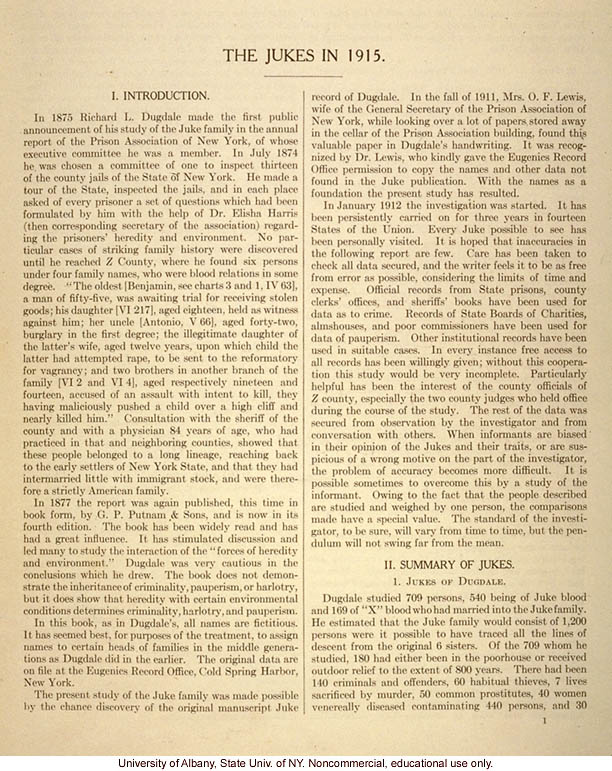The Jukes in 1915, by Arthur H. Estabrook, selected pages (5)

The Jukes in 1915, by Arthur H. Estabrook, selected pages (5)
1374. The Jukes in 1915. [score] I. Introduction. In 1875 Richard Dugdale made the first public announcement of his study of the Juke family in the annual report of the Prison Association of New York, of whose executive committee he was a member. In July 1874 he was chosen a committee of one to inspect thirteen of the county jails of the State of New York. He made a tour of the State, inspected the jails, and in each place asked of every prisoner a set of questions which had been formulated by him with the help of Dr. Elisha Harris (then corresponding secretary of the association) regarding the prisoners' heredity and environment. No particular cases of striking family history were discovered until he reach Z County, where he found six persons under four family names, who were blood relations in some degree. "The oldest (Benjamin, see charts 3 and 1, IV 63), a man of fifty-five, was awaiting trial for receiving stolen goods; his daughter, (VI 217) aged eighteen, held as witness against him; her uncle (Antonio, V 66), aged forty-two, burglary in the first degree; the illegitimate daughter of the latter's wife, aged twelve years, upon which child the latter had attempted rape, to be sent to the reformatory for vagrancy; and two brothers in another branch of the faily (VI 2 and VI 4), aged respectively nineteen and fourteen, accused of assault with intent to kill, they having maliciously pushed a child over a high cliff and nearly killed him." Consultation with the sheriff of the county and with a physician 84 years of age, who had practiced in that and neighboring counties, showed that these people belonged to a long lineage, reaching back to the early settlers of New York State, and that they had intermarried little with immigrant stock, and were therefore a strictly American family. In 1877 the report was again published, this time in book form, by G. P. Putnam & Sons, and is now in its fourth edition. The book has been widely read and has had a great influence. It has stimulated discussion and led many to study the interaction of the "forces of heredity and environment." Dugdale was very cautious in the conclusions which he drew. The book does not demonstrate the inheritance of criminality, pauperism, or harlotry, but it does show that heredity with certain environmental conditions determines criminality, harlotry, and pauperism. In this book, as in Dugdale's, all names are fictitious. It has seemed best, for purposes of treatment, to assign names to certain heads of families in the middle generations as Dugdale did in the earlier. The original data are on file at the Eugenics Record Office, Cold Spring Harbor, New York. The present study of the Juke family was made possible by the chance discovery of the original manuscript Juke record of Dugdale. In the fall of 1911, Mrs. O. F. Lewis, wife of the General Secretary of the Prison Association of New York, while looking over a lot of papers stored away in the cellar of the Prison Association building, found this valuable paper in Dugdale's handwriting. It was recognized by Dr. Lewis, who kindly gave the Eugenics Record Office permission to copy the names and other data not found in the Juke publication. With the names as a foundation the present study has resulted. In January 1912 the investigation was started. It has been persistently carried on for three years in fourteen States of the Union. Every Juke possible to see has been personally visited. It is hoped that inaccuracies in the following report are few. Care has been taken to check all data secured, and the writer feels it to be as free from error as possible, considering the limits of time and expense. Official records from the State prisons, county clerks' offices, and sheriffs' books have been used for data as to crime. Records of the State Board of Charities, almshouses, and poor commissioners have been used for data of pauperism. Other institutional records have been used in suitable cases. In every instance free access to all records has been willingly given; without this cooperation this study would be very incomplete. Particularly helpful has been the interest of the county officials of Z county, especially the two county judges who held office during the course of the study. The rest of the data was secured from observation by the investigator and from conversation with others. When informants are biased in their opinion of the Jukes and their traits, or are suspicious of a wrong motive on the part of the investigator, the problem of accuracy becomes more difficult. It is possible sometimes to overcome this by a study of the informant. Owing to the fact that the people described are studied and weighed by one person, the comparisons made have a special value. The standard of the investigator, to be sure, will vary from time to time, but the pendulum will not swing far from the mean. II. Summary of Jukes. 1. Jukes of Dugdale. Dugdale studied 709 persons, 540 being of Juke blood and 169 of "X" blood who had married into the Juke family. He estimated that the Juke family would consist of 1,200 persons were it possible to have traced all the lines of descent from the original 6 sisters. Of the 709 whom he studied, 180 had either been in the poorhouse or received outdoor relief to the extent of 800 years. There had been 140 criminals and offenders, 60 habitual thieves, 7 lives sacrificed by murder, 50 common prostitutes, 40 women venereally diseased contaminating 440 persons, and 30 [end]
- ID: 11338
- Source: DNALC.EA


